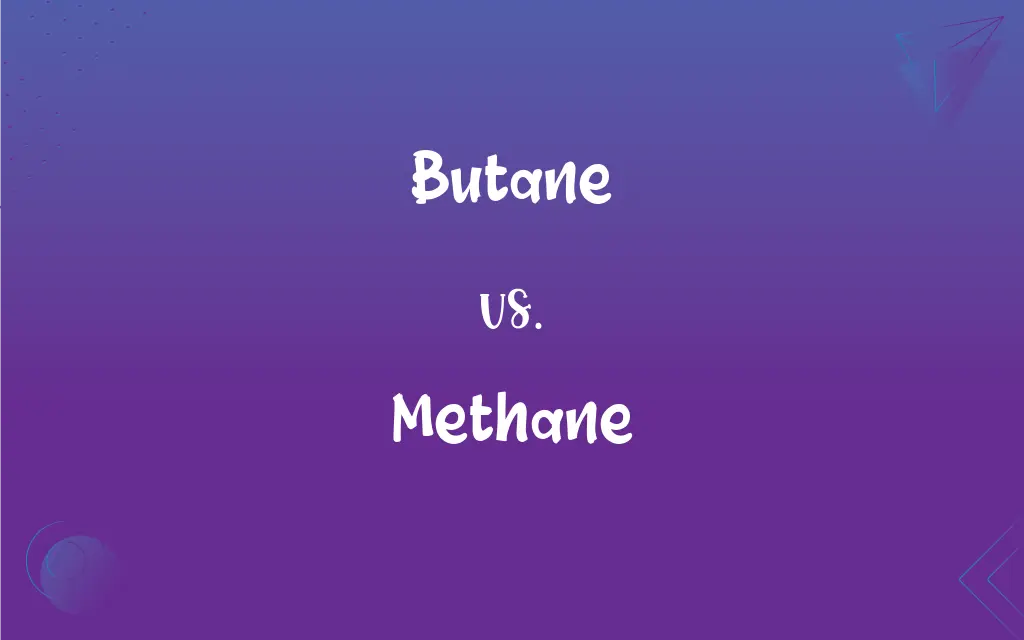Butane vs. Methane: What's the Difference?
Edited by Aimie Carlson || By Janet White || Published on January 12, 2024
Butane (C4H10) is a heavier, liquefiable gas used in fuel canisters; Methane (CH4), the simplest hydrocarbon, is a primary component of natural gas.

Key Differences
Butane, with the chemical formula C4H10, is a saturated hydrocarbon consisting of four carbon atoms. Methane, CH4, is the simplest hydrocarbon with one carbon atom, forming the basis of more complex hydrocarbons.
Butane is a heavier gas that easily liquefies under moderate pressure, making it suitable for storage in gas canisters. Methane is a lighter gas and remains gaseous under standard conditions, requiring compression or liquefaction for storage.
Butane is derived from natural gas and crude oil processing, being a minor component of natural gas. Methane is a major component of natural gas and can also be produced biologically in environments like wetlands or through anaerobic digestion.
Butane is commonly used as a fuel in lighters, portable stoves, and as a propellant. Methane has a wider range of uses, including as a fuel for heating, electricity generation, and as a feedstock in the chemical industry.
Both butane and methane are greenhouse gases. Methane, however, has a much higher global warming potential in the short term compared to butane, making its emissions particularly concerning in terms of climate change.
ADVERTISEMENT
Comparison Chart
Chemical Formula
C4H10
CH4
State at Room Temperature
Easily liquefied
Remains gaseous
Natural Sources
Natural gas, crude oil
Natural gas, biological processes
Common Uses
Lighters, portable stoves
Heating, electricity generation
Environmental Impact
Greenhouse gas
High global warming potential
ADVERTISEMENT
Butane and Methane Definitions
Butane
Liquefies easily, making it convenient for transport and storage.
Butane is stored in liquid form in lighter refills.
Methane
Used as a fuel and in chemical synthesis.
Methane is a key ingredient in the production of hydrogen gas.
Butane
Utilized in the petrochemical industry for various products.
Butane is a raw material in the production of synthetic rubber.
Methane
Produced biologically in anaerobic environments.
Methane is generated in wetlands and by ruminant digestion.
Butane
A flammable hydrocarbon gas used in portable fuel sources.
The camping stove uses butane canisters for fuel.
Methane
The simplest alkane, a major component of natural gas.
Methane is harnessed from natural gas fields for energy.
Butane
A gaseous component of natural gas and petroleum.
Butane is extracted during the refining process of natural gas.
Methane
Exists in gaseous form under normal conditions.
Methane needs to be compressed for use as a fuel in vehicles.
Butane
Commonly used as a propellant in aerosol sprays.
Many hair sprays contain butane as a propellant.
Methane
A greenhouse gas with significant impact on global warming.
Reducing methane emissions is crucial for climate change mitigation.
Butane
Either of two isomers of a gaseous hydrocarbon, C4H10, produced synthetically from petroleum and used as a household fuel, refrigerant, and aerosol propellant and in the manufacture of synthetic rubber.
Methane
An odorless, colorless, flammable gas, CH4, the major constituent of natural gas, that is used as a fuel and is an important source of hydrogen and a wide variety of organic compounds.
Butane
(organic compound) A hydrocarbon (either of the two isomers of C4H10 n-butane, and 2-methyl-propane) found in gaseous petroleum fractions.
Methane
The simplest aliphatic hydrocarbon, CH₄, being a constituent of natural gas, and one of the most abundant greenhouse gases.
Greenhouse gas
Cattle emit a large amount of methane.
Butane
The n-butane isomer only.
Methane
Any of very many derivatives of methane.
Butane
An inflammable gaseous saturated hydrocarbon, C4H10, of the marsh gas, or paraffin, series.
Methane
A light, colorless, gaseous, inflammable hydrocarbon, CH4; marsh gas. It is the simplest of the aliphatic hydrocarbons. See Marsh gas, under Gas.
Butane
Occurs in natural gas; used in the manufacture of rubber and fuels
Methane
A colorless odorless gas used as a fuel
FAQs
Where is butane found?
Butane is found in natural gas and during petroleum refining.
How is methane stored?
Methane is stored under high pressure or in liquefied form.
Is butane a greenhouse gas?
Yes, butane contributes to the greenhouse effect, though less than methane.
What is methane?
Methane is the simplest alkane, primarily used as a fuel and in chemical processes.
How is butane stored?
Butane is stored as a liquid under pressure in canisters or tanks.
Where is methane found?
Methane is found in natural gas reserves and produced biologically.
Is methane toxic?
Methane is not toxic, but can displace oxygen, leading to asphyxiation.
Can butane be used in vehicles?
Butane is less commonly used in vehicles compared to methane.
Is butane toxic?
Butane is not highly toxic but can be harmful in high concentrations.
What is butane?
Butane is a flammable hydrocarbon gas, used in fuels and as a propellant.
Is methane a greenhouse gas?
Yes, methane is a potent greenhouse gas with a significant impact on climate.
What is the chemical formula of methane?
The chemical formula of methane is CH4.
How do butane and methane affect the environment?
Both are greenhouse gases, with methane having a greater impact on global warming.
What are the main uses of butane?
Butane is used in lighters, portable stoves, and as a propellant.
Are butane and methane renewable?
While primarily sourced from fossil fuels, biologically-produced methane is renewable; butane is not typically considered renewable.
Can methane be used in vehicles?
Yes, methane is used as CNG (Compressed Natural Gas) in vehicles.
What are the main uses of methane?
Methane is used for heating, electricity generation, and in chemical industries.
How are butane and methane produced?
Butane is produced during natural gas processing and oil refining; methane is a primary component of natural gas and is also biologically produced.
Can butane and methane be used interchangeably?
They are not typically interchangeable due to different properties and applications.
What is the chemical formula of butane?
The chemical formula of butane is C4H10.
About Author
Written by
Janet WhiteJanet White has been an esteemed writer and blogger for Difference Wiki. Holding a Master's degree in Science and Medical Journalism from the prestigious Boston University, she has consistently demonstrated her expertise and passion for her field. When she's not immersed in her work, Janet relishes her time exercising, delving into a good book, and cherishing moments with friends and family.
Edited by
Aimie CarlsonAimie Carlson, holding a master's degree in English literature, is a fervent English language enthusiast. She lends her writing talents to Difference Wiki, a prominent website that specializes in comparisons, offering readers insightful analyses that both captivate and inform.






































































